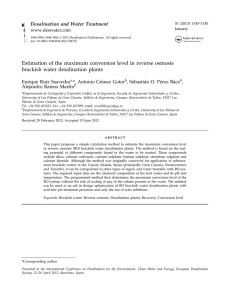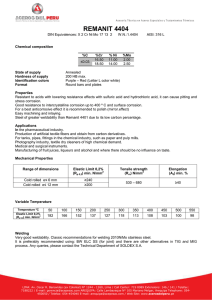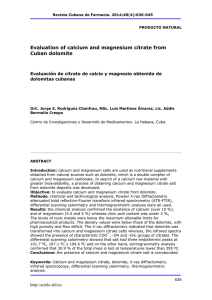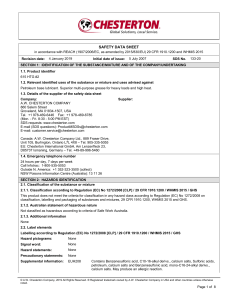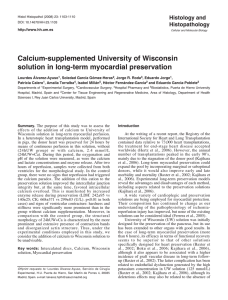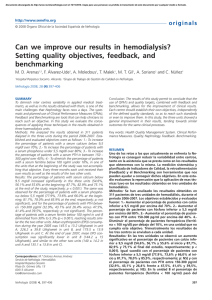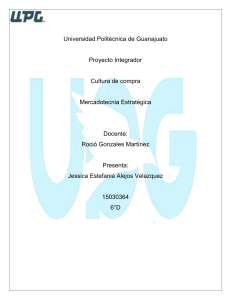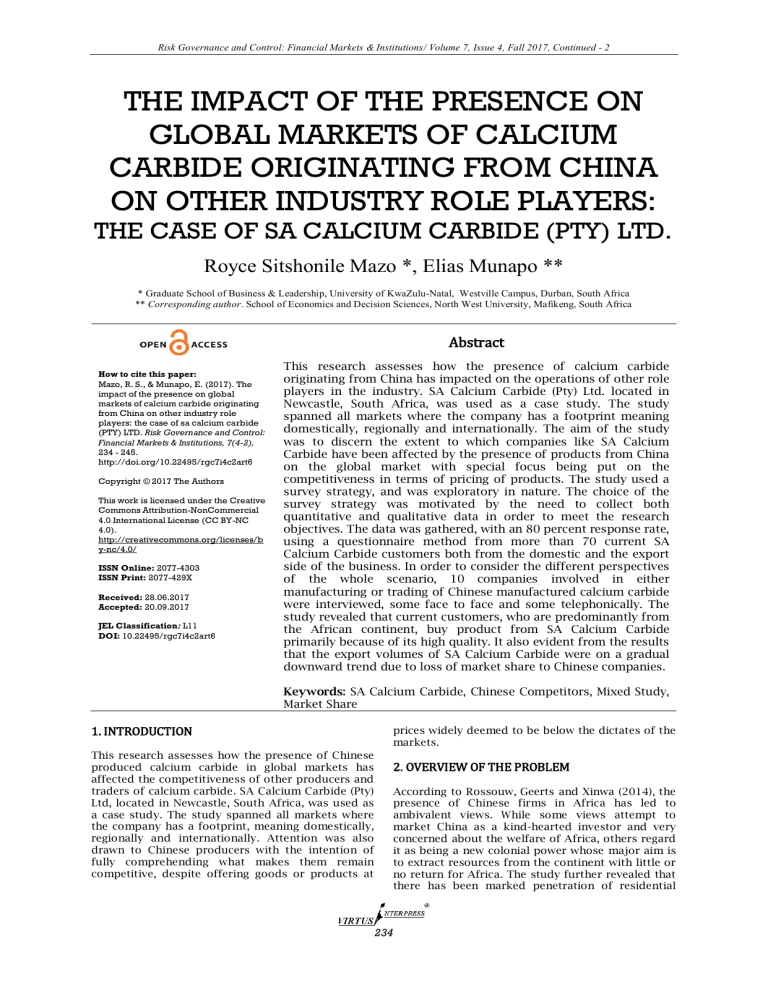
Risk Governance and Control: Financial Markets & Institutions/ Volume 7, Issue 4, Fall 2017, Continued - 2 THE IMPACT OF THE PRESENCE ON GLOBAL MARKETS OF CALCIUM CARBIDE ORIGINATING FROM CHINA ON OTHER INDUSTRY ROLE PLAYERS: THE CASE OF SA CALCIUM CARBIDE (PTY) LTD. Royce Sitshonile Mazo *, Elias Munapo ** * Graduate School of Business & Leadership, University of KwaZulu-Natal, Westville Campus, Durban, South Africa ** Corresponding author. School of Economics and Decision Sciences, North West University, Mafikeng, South Africa Abstract How to cite this paper: Mazo, R. S., & Munapo, E. (2017). The impact of the presence on global markets of calcium carbide originating from China on other industry role players: the case of sa calcium carbide (PTY) LTD. Risk Governance and Control: Financial Markets & Institutions, 7(4-2), 234 - 245. http://doi.org/10.22495/rgc7i4c2art6 Copyright © 2017 The Authors This work is licensed under the Creative Commons Attribution-NonCommercial 4.0 International License (CC BY-NC 4.0). http://creativecommons.org/licenses/b y-nc/4.0/ ISSN Online: 2077-4303 ISSN Print: 2077-429X Received: 28.06.2017 Accepted: 20.09.2017 JEL Classification: L11 DOI: 10.22495/rgc7i4c2art6 This research assesses how the presence of calcium carbide originating from China has impacted on the operations of other role players in the industry. SA Calcium Carbide (Pty) Ltd. located in Newcastle, South Africa, was used as a case study. The study spanned all markets where the company has a footprint meaning domestically, regionally and internationally. The aim of the study was to discern the extent to which companies like SA Calcium Carbide have been affected by the presence of products from China on the global market with special focus being put on the competitiveness in terms of pricing of products. The study used a survey strategy, and was exploratory in nature. The choice of the survey strategy was motivated by the need to collect both quantitative and qualitative data in order to meet the research objectives. The data was gathered, with an 80 percent response rate, using a questionnaire method from more than 70 current SA Calcium Carbide customers both from the domestic and the export side of the business. In order to consider the different perspectives of the whole scenario, 10 companies involved in either manufacturing or trading of Chinese manufactured calcium carbide were interviewed, some face to face and some telephonically. The study revealed that current customers, who are predominantly from the African continent, buy product from SA Calcium Carbide primarily because of its high quality. It also evident from the results that the export volumes of SA Calcium Carbide were on a gradual downward trend due to loss of market share to Chinese companies. Keywords: SA Calcium Carbide, Chinese Competitors, Mixed Study, Market Share 1. INTRODUCTION This research assesses how the presence of Chinese produced calcium carbide in global markets has affected the competitiveness of other producers and traders of calcium carbide. SA Calcium Carbide (Pty) Ltd, located in Newcastle, South Africa, was used as a case study. The study spanned all markets where the company has a footprint, meaning domestically, regionally and internationally. Attention was also drawn to Chinese producers with the intention of fully comprehending what makes them remain competitive, despite offering goods or products at prices widely deemed to be below the dictates of the markets. 2. OVERVIEW OF THE PROBLEM According to Rossouw, Geerts and Xinwa (2014), the presence of Chinese firms in Africa has led to ambivalent views. While some views attempt to market China as a kind-hearted investor and very concerned about the welfare of Africa, others regard it as being a new colonial power whose major aim is to extract resources from the continent with little or no return for Africa. The study further revealed that there has been marked penetration of residential 234 Risk Governance and Control: Financial Markets & Institutions/ Volume 7, Issue 4, Fall 2017, Continued - 2 areas and informal settlements by Chinese traders who are offering products at lower prices compared to those being offered by African counterparts, be it traders or producers. The influx of goods imported from China is not particular to Africa alone. Exports promotion, while having protectionist measures for the domestic market, has been described as being the cornerstone of China's transition to a market economy (Defever & Riaño, 2013). There exists a school of thought that the cheap products from China contribute to the undermining of the development of Africa by prohibiting or thwarting the growth of the manufacturing sector, which under normal circumstances would have created jobs and wealth (Rossouw, Geerts, & Xinwa, 2014). This argument is however countered by (Liang, 2013) who argues that of the main imports from China into Africa, about 51%, is machinery and equipment for the transportation sector. These are of absolute necessity in boosting the development of the industrial sector of Africa. Consistent among themes pertaining to Chinese products is the perception that they are of inferior quality (Gadzala, 2010). To counter this widely held perception, a lot of measures exemplified by quality examinations before shipping of industrial products that were meant for exports were introduced (Embassy of the Republic of China, 2014). These measures help to ensure that the quality of Chinese commodities exported is guaranteed. 2.1. An overview of the calcium carbide sector of China Table 1. Chinese calcium carbide industry output and consumption levels Year 2000 2010 Output (T) 3 400 000 16 500 000 Capacity (T) 4 800 000 22 500 000 Operation Rate 70.8% 65% Export Volume (T) 100 000 140 000 Apparent Consumption (T) 3 300 000 16 360 000 Adapted from China Chemical Reporter (2015) 2011 18 500 000 24 000 000 72.4% 185 000 18 310 000 2012 20 000 000 32 300 000 61.9% 158 000 19 840 000 2013 23 000 000 38 000 000 60.5% 143 000 22 860 000 Synthesis of organic solvents required in the pharmaceutical and dyestuff industries Production of organic solvents required in the manufacturing of synthetic rubber and plastics (polyvinyl chloride or PVC) Production of desulphuriser blends and deoxidants for the steel industry (Andina Group, 2008). SA Calcium Carbide (Pty) Ltd, abbreviated as SACC is situated on the outskirts of the town of Newcastle in the province of KwaZulu-Natal in the Republic of South Africa (Andina Group, 2008). It is the only calcium carbide producer in Africa and has been in the business since the 1970s (Kwakernaak, 2015). Comment It is evident from the Table 1 above that although China consumes more than 90 percent of its own carbide, the export volumes are still very high. Any decline in consumption of calcium carbide within China, say because of the oversupply of polyvinyl chloride, where the carbide finds its most use, may increase the risk of dumping the product in the global market. According to Yu (2014), ‘Capacity growth is unduly rapid and overcapacity is already serious.’ The question therefore relates to whether local manufacturers such as SA Calcium Carbide (Pty) Ltd could also become very competitive and sustain their edge in the global export market if they were to operate within the same markets the Chinese firms operate in? Is there hope then for South Africa’s very own local producers to ward off competition from beyond the borders and thus lessen the overall impact of the presence of the Chinese manufactured goods on the local markets? 2.3. Problem statement It is perceived by South African calcium carbide producers and traders that the presence on global markets of the same product originating from China has had a profound negative impact on their competitiveness (Kwakernaak, 2015). 2.2. Information on calcium carbide and SA Calcium Carbide (Pty) Ltd. 3. RESEARCH METHODOLOGY Commercial calcium carbide, chemical formula CaC 2, has colour variations from steel grey to reddish brown depending on the impurities it contains and also depending on the method of manufacturing (ASCC Pvt. Ltd, 2010). The article further explains that the chemical is produced from a reaction of lime and carbon in an electric arc furnace where temperatures of about 2300oC are required, and thus a large amount of electricity is consumed. Some of the many uses of calcium carbide as listed in the same report are: Manufacturing of calcium cyanamide Acetylene for oxyacetylene welding 3.1. Aim and objectives of the study The aim of the study was to discern the extent to which companies like SA Calcium Carbide have been affected by the presence of products from China on the global market with special focus being put on the competitiveness in terms of pricing of products. The following were the objectives of the study: Find out what motivates current customers to buy from SA Calcium Carbide. The study covered current customers both from the domestic side and from the export side, regionally and internationally. 235 Risk Governance and Control: Financial Markets & Institutions/ Volume 7, Issue 4, Fall 2017, Continued - 2 Establish what the current prices of calcium carbide are as offered by the Chinese companies on the global market. Various sources for current prices are readily available including marketing information given to SA Calcium Carbide current customers. African customer visits to establish rapport and gather market intelligence are also planned for this purpose. Establish the magnitude of the threat posed by the Chinese products to a company such as SA Calcium Carbide. This would be achieved through assessment of its current customers’ opinions with regard to Chinese product quality, lead times to delivery, sales support and pricing of products. Investigate what is sustaining the Chinese producers’ value proposition at present. This is going to be achieved through an analysis of their production processes and models, a study of Chinese regulations, current average wages in China, safety records of Chinese companies, quality endorsements certificates for Chinese producers etc. For this the first prize was a visit to China. Telephonic interviews were also planned. Draw up a list of recommendations on what strategies companies such as SA Calcium Carbide could employ to remain competitive and retain existing market share whilst still operating profitably and in a sustainable manner. The calcium carbide study was exploratory. This was because a lot of work needed to be done beforehand to understand the global market for calcium carbide and to fully comprehend the impact of the presence of Chinese manufactured product on SA Calcium Carbide (Pty) Ltd. Although some facts were known from literature, more information needed to be gathered so as to be able to come up with a viable theoretical framework. The exploratory study relied on secondary research through a critical review of literature and both quantitative and qualitative approaches to gather data. 3.2. Study setting According to (Sekaran & Bougie, 2014), a research study setting can either be contrived or noncontrived. Contrived is when an artificial environment is created in which the events are under strict control. In this case the researchers seek the establishment of a cause-effect relationship beyond any reasonable doubt. In contrast a noncontrived setting is the environment that is natural and allows normal occurrence of events typified by field studies where there is minimal interference by the researchers. The study setting adopted in this research was non-contrived as there was minimal interference by the researchers and the events were left to proceed normally. 3.3. Research strategies Mixed methods involve integrating the collection and analysis of both quantitative and qualitative data in a single study (Cresswell, 2003). The aim of this type of research is that both research methods, when used in unison, lead to a better comprehension of a research problem than if each of the methods is used individually (Bulsara, 2012). Mixed methods were used for this study because: The different methods for collection of data ensure greater validity of the research. A number of perspectives are considered in answering the research question. Ascertains the absence of gaps to collected data and Ensures that there is less likelihood of the researchers having preconceived notions and assumptions. A case study of SA Calcium Carbide (Pty) Ltd was used in order to fully grasp the impact of the presence of Chinese material on global markets. This was largely achieved through the examination of the real-life situation from various angles and perspectives as dictated by the objectives given above and using multiple methods of data collection. The benefits of the mixed methods approach were thus harnessed. 3.4. Unit of analysis The unit of analysis bears reference to the extent to which the gathered data is aggregated during the stage of analysis of data (Sekaran & Bougie, 2014). These authors further explained the necessity of making a decision on the unit of analysis during the formulation of the research question. The methods used for the collection of data, the size of the sample, and even the variables covered by the framework may sometimes be dependent on the extent to which data are aggregated for analysis. The units of analysis can be individuals, dyads, groups, divisions, industry or countries. The data was gathered from more than 70 current SA Calcium Carbide customers both from the domestic and the export side of the business. Traders in Chinese products were also interviewed. It thus suffices to state that the calcium carbide industry as a whole was the unit of analysis. 3.5. Time horizon For the purposes of this study the data was gathered just once from SA Calcium Carbide customers and also from Chinese product traders over a period of weeks in order to find answers to the research questions. A cross-sectional study was very ideal to keep costs at minimum and to complete the research within the relatively limited time available. 3.6. The sampling process In this study the target population was all the endusers and traders of calcium carbide from SA Calcium Carbide located locally, regionally and internationally. Chinese manufacturers and traders dealing in the same product were also targeted. The total number of SA Calcium Carbide customers is about one hundred and forty and that of the Chinese manufacturers and traders about twenty (Kwakernaak, 2015). The population therefore consisted of one hundred and sixty elements. 236 Risk Governance and Control: Financial Markets & Institutions/ Volume 7, Issue 4, Fall 2017, Continued - 2 Showing keen interest in what the respondent was saying Tact was exercised in the asking of the questions Repeating and/or clarification of the questions posed Some of the responses were paraphrased to ensure that they were not misunderstood. Recording of the responses as accurately as possible. The researcher explicitly stated the purpose of the interview and assured the respondents complete confidentiality. 3.7. Determination of the sample frame For purposes of this study SA Calcium Carbide customers’ and competitors’ database served as the sampling frame. 3.8. Determination of the sample design A combination of convenience sampling and judgement sampling was the technique of choice employed in this study. Convenience sampling allowed the researchers to collect data from calcium carbide role players in the global market who are already SA Calcium Carbide (Pty) Ltd customers and therefore were conveniently available to provide research data. Judgement sampling on the other hand offered the researchers the freedom to select subjects who reasonably comprehended the calcium carbide business and industry so that they could provide informed opinions in their response to the research questions. It thus suffices to state that the use of the two methods in unison offered the researchers an opportunity to collect data in a quick, efficient and relatively inexpensive way. Interviews administration 3.9. Determination of the sample size The approach in the sample size determination for this study was based on the approach more suited for probability sampling. Krejcie and Morgan (1970, cited in Sekaran & Bougie, 2014) greatly simplified the determination of sample size by providing a table that ensures a good decision model. According to the table, for a target population size of N = 160 elements, the sample size is n = 110 subjects. 3.10. Data collection The methods used to gather data are an essential part of any research design. Data collection methods employed in this study For the purposes of this study both semi-structured interview and questionnaire methods were used. The interview questions were designed in such a way that they would be able to solicit information from Chinese calcium carbide suppliers and traders. The main objective of the interview questions was to find out what the Chinese suppliers’ and traders’ value proposition was. On the other hand the questionnaire was meant for the current SA Calcium Carbide (Pty) Ltd customers. This questionnaire was designed to gather information pertinent to how Chinese calcium carbide producers and suppliers have impacted the world industry as a whole through their pricing of the product, with special emphasis being put on current SA Calcium Carbide (Pty) Ltd customers. Eliminating bias and establishment of credibility and rapport In carrying out this study the researcher employed the following tactics to minimise bias (Sekaran & Bougie, 2014): Paying close attention to the interviewee Both face to face and over the telephone methods were used to gather the data from the targeted respondents. For the purposes of this study, face to face interviews with managers responsible for procurement were done with two companies in the United Arab Emirates, one in Oman and two companies in South Africa. All the five companies are currently trading in Chinese manufactured calcium carbide and are big role players in the global market of the industry. Telephonic interviews were done to gather data from the other five Chinesebased companies that manufacture calcium carbide. Questionnaire design A structured questionnaire designed for this study sought to answer key research questions related to the research objectives. A funnel approach recommended by Sekaran and Bougie (2014) was used in which general questions were first raised before gradual progression to the more specific questions. Closed type questions were mainly used in which the respondents had to make a choice of the alternatives presented to them. An open ended question was however included at the end to allow the respondents to comment on any aspect they had chosen. Questionnaire administration Consent was sought from the respondents before they could participate in the survey. The informed consent was the preamble of the questionnaire, and respondents could not continue with the survey until they had acknowledged that they fully understood what the research objectives were, and were comfortable to do so. The questionnaires were emailed to the intended respondents since they were already SA Calcium Carbide customers and were part of the database. 3.11. Scaling Scaling involves the creation of a continuum on which objects are located (Sekaran & Bougie, 2014). The following types of rating scales were used for this questionnaire: Category scales – This makes use of multiple items to elicit a unitary response and also uses a nominal scale. Multiple choice – Single response scales – These scales are used to offer the respondents a 237 Risk Governance and Control: Financial Markets & Institutions/ Volume 7, Issue 4, Fall 2017, Continued - 2 single choice from a list of alternatives (Hou & Lissitz, 2012). Likert scales –The scale is designed to examine how strongly subjects agree or disagree with statements on a five point scale anchored by variations of the ‘agree’ and ‘disagree’ responses (Sekaran & Bougie, 2014). Numerical scale – It is a scale where several bipolar attributes are identified at the extremes of the scale, and respondents are asked to indicate their attitudes, on what may be called a semantic space (Sekaran & Bougie, 2014) 3.12. Meeting research objectives from related questions Questions in the questionnaire and the interview were structured in such a way that they sought responses designed to answer some of the key research questions of the study and thus meet the research objectives. 3.13. Pretesting questionnaire of the interview and the Both the interview questions and the questionnaire were pre-tested among fellow work colleagues in the sales and marketing division at SA Calcium Carbide (Pty) Ltd. The pilot study group were first presented with the objectives of the interview and also the questionnaire. The pre-tests highlighted some ambiguities and question sequencing problems. These were then subsequently addressed following recommendations from the pilot group before subsequently using them in the main study. 3.14. Validation and reliability of the interview schedule and the questionnaire Validation Content validity for this study was established by means of the feedback obtained from the sales and marketing division of SA Calcium Carbide during the pre-tests of the interview and the questionnaire. Construct validity was established, as suggested by Sekaran and Bougie (2014), using measures that are published for various concepts relating to interview and questionnaire methods in order for the user or reader to be able to judge the goodness of the measures. Reliability Reliability refers to the extent to which measures are accurate and therefore produce results that are consistent (Thanasegaran, 2009). In order to review the reliability of the instruments used in the research, the criteria suggested by (Saunders, Lewis, & Thornhill, 2009) were used. Subject or participant error – This was avoided by approaching interview participants at periods convenient to them. Ample time was also given to the questionnaire participants not to rush through the responses. Subject or participant bias – This was prevented by emphasising to each respondent that anonymity was guaranteed. This was clearly stated before the onset of the interview and also on the cover page of the questionnaire. Observer error – This was circumvented by using a structured questionnaire for the SA Calcium Carbide existing customers and a structured interview method for the respondents dealing with the Chinese calcium carbide. Observer bias – This was non-existent, as the researcher used the interview and the questionnaire research designs. Summarily, every effort was made to ensure that the research was conducted impartially and that the interpretation of the data was done using a scientific and objective approach. There is therefore every reason to believe that if other researchers were to carry out the same study the results would be comparable. 4. PRESENTATION OF FINDINGS This section is organised into two parts with the first part focussing on the responses captured using the questionnaire that was administered on the current customers of S.A Calcium Carbide (Pty) Ltd, and the second part concentrating on the responses obtained from the interviews done with both traders and manufacturers of Chinese calcium carbide. Of the 110 subjects targeted, a total of 88 participated in the study, giving a response rate of 80 percent. The split for the respondents was 78 out of 100 for the questionnaire and 10 out of 10 for interview participation. The results are summarized in Tables 1 to 9 and figures 1 to 10. 4.1. Questionnaire responses The presentation of the questionnaire results was done according to the following categories: Demographic profile of participants S.A Calcium Carbide product quality S.A Calcium Carbide lead times for product delivery S.A Calcium Carbide before and after sales support S.A Calcium Carbide product price S.A Calcium Carbide reputation Narrative text for other reasons for buying from S.A Calcium Carbide (Pty) Ltd. For calcium carbide originating from China Product quality Lead times for product delivery After sales and before sales support Pricing of product Narrative text for any other comments regarding Chinese calcium carbide. 4.1.2. Demographic profile of respondents The demographic profile of the current S.A Calcium Carbide (Pty) Ltd customers included the continent located (from the country given), the nature of the business, the quantity of calcium carbide handled per year, the experience in the industry and the application of the product after purchase. This information was critical in the determination of whether the differences in these factors had a 238 Risk Governance and Control: Financial Markets & Institutions/ Volume 7, Issue 4, Fall 2017, Continued - 2 bearing on the responses to the ensuing assessment questions. Number of S.A Calcium Carbide Customers Figure 1. Continent demographics of respondents 60 48 50 40 30 16 20 3 2 5 Europe N. America S. America 4 10 0 Africa Asia Australia Continent Table 2. Frequencies table showing continent demographic of respondents Frequency 48 16 4 3 2 5 78 Africa Asia Australia Europe North America South America TOTAL % 61.5 20.5 5 4 2.5 6.5 100 Cumulative % 61.5 82 87 91 93.5 100 100 Nature of Business Figure 2. Type of business demographics of respondents Both 2 Trader 24 Direct Consumer 52 0 10 20 30 40 50 60 Number of Respondents Table 3. Frequencies table showing nature of business demographics of respondents Frequency 24 52 2 78 Trader Direct Consumer Both TOTAL % 30.8 66.7 2.5 100 Cumulative % 30.8 97.5 100 100 4.1.3. Quantity of calcium carbide handled per annum Volume of Calcium Carbide Handled per Annum Figure 3. Number of respondents and carbide handled per year 1000 to < 10000 tonnes 23 500 to < 1000 tonnes 37 100 to < 500 tonnes 14 < 100 tonnes 4 0 5 10 15 20 25 30 Number of Respondents Table 4. Frequencies table quantity of calcium carbide handled per annum 239 35 40 Risk Governance and Control: Financial Markets & Institutions/ Volume 7, Issue 4, Fall 2017, Continued - 2 Tonnages < 100 100 to < 500 500 to < 1000 1000 to < 10000 TOTAL Frequency 4 14 37 23 78 % 5 18 47.5 29.5 100 Cumulative Frequency 5 23 70.5 100 100 4.1.4. Calcium carbide industry experience Number of Years in Industry Figure 4. Calcium carbide industry experience demographic of respondents > 20 Years 13% 10 to < 20 Years 45% 5 to < 10 Years 33% < 5 Years 9% 0% 5% 10% 15% 20% 25% 30% 35% 40% 45% 50% % of Total Respondents 4.1.5. Calcium carbide application Calcium Carbide Application Figure 5. Calcium carbide application demographics of respondents Other 5 Resale 24 Steel Making Application 8 Acetylene Generation 41 0 5 10 15 20 25 30 35 40 45 Number of Respondents Table 5. Frequency table for calcium carbide application demographic Frequency 5 24 8 41 78 Percent 6.5 30.7 10.3 52.5 100 4.2. Interview results The presentation of the Interview results was done according to the following categories: Demographic profile of participants Assessment of the importance of capabilities driving companies’ profitability Narrative text of other responses obtained. Of the 10 companies that participated in the interviews 5 were manufacturers of calcium carbide based in China and 2 were traders of calcium carbide based in United Arab Emirates, one was a Cumulative Frequency 6.5 37.2 47.5 100 100 Application Other Resale Steel making Acetylene generation TOTAL trader based in Oman and the other 2 traders were based in South Africa. 4.2.1. Demographic profile of interview respondents The demographic profile of the respondents dealing in Chinese manufactured calcium carbide included the country of location, the nature of the business, the quantity of calcium carbide handled per year, the experience in the industry and the source of main raw materials. This information was critical in the determination of whether the differences in these factors had a bearing on the responses to the ensuing interview questions. 240 Risk Governance and Control: Financial Markets & Institutions/ Volume 7, Issue 4, Fall 2017, Continued - 2 Number of Respondents Figure 6. Country demographic of interview respondents 6 5 4 3 2 1 0 5 2 2 1 China United Arab Emirates Oman South Africa Country of location Table 6. Frequency table of country demographic Frequency 5 2 1 2 10 China UAE Oman South Africa TOTAL % 50 20 10 20 100 Cumulative % 50 70 80 100 100 4.2.2. Nature of business Nature of Business Figure 7. Type of business demographic of respondents Calcium carbide trader 5 Calcium carbide manufacturer 5 0 1 2 3 4 5 6 Number of Respondents Table 6. Nature of business demographic frequency table Frequency 5 5 10 Trader Manufacturer TOTAL % 50 50 100 Cumulative % 50 100 100 4.2.3. Quantity of calcium carbide handled per annum Quantity of Calcium Carbide Handled per Year Figure 8. Number of respondents and carbide quantity handled per year ≥ 100000 tonnes 4 50000 to < 100000 tonnes 1 10000 to < 50000 tonnes 3 < 10000 tonnes 2 0 0,5 1 1,5 2 2,5 3 Number of Respondents 241 3,5 4 4,5 Risk Governance and Control: Financial Markets & Institutions/ Volume 7, Issue 4, Fall 2017, Continued - 2 Table 8. Frequency Table of Calcium carbide handled per year Tonnages < 10000 10000 to < 50000 50000 to < 100000 ≥ 100000 TOTAL Frequency 2 3 1 4 10 % 20 30 10 40 100 Cumulative Frequency 20 50 60 100 100 4.2.4. Industry experience of Chinese manufacturers or traders Experience in the Calcium Carbide Industry Figure 9. Calcium carbide industry experience demographic of interview respondents > 20 Years 30% 10 to < 20 Years 40% 5 to < 10 Years 20% < 5 Years 10% 0% 5% 10% 15% 20% 25% 30% 35% 40% 45% % of Respondents 4.2.5. Source of raw materials for Chinese calcium carbide manufacturers Figure 10. Source of main raw materials demographics of respondents Number of Respondents 4 3 3 2 1 1 1 Locally Sourced Imported 0 Both Source of Main Raw Materials Table 9. Frequency table of source of raw materials Main Raw Materials Locally Sourced Imported Both TOTAL Frequency 1 1 3 5 The data collected was both a reflection of the participants’ personal views and the facts already captured in the companies’ databases. The information that emerged from the collected data provided the researchers with a basis to articulate the various facets encapsulated in the research objectives. This was achieved through employment of both quantitative and qualitative approaches to gather the data. The questionnaire was designed specifically for existing S.A Calcium Carbide customers spread across the world, with the questions seeking to elicit responses that would shed light on what counts on the company’s favour at present and to capture their views on the Chinese product present in the market. The aim was thus to Percent 20 20 60 100 Cumulative Frequency 20 40 100 100 evaluate the threat posed by the presence of the substitute product and ultimately decide how S.A Calcium Carbide can remain competitive and thus retain existing or increase market share. On the other hand interviews were done with the major producers of calcium carbide in China with the aim of assessing what makes them competitive and to comprehend what they consider as their value proposition. Traders solely dealing in calcium carbide from China were also targeted or the interviews. Prices of calcium carbide were obtained by checking current invoices and the historical figures mainly from interviews. The next section focuses on the interpretation and discussion of the research findings with 242 Risk Governance and Control: Financial Markets & Institutions/ Volume 7, Issue 4, Fall 2017, Continued - 2 comparisons drawn with existing literature and previous studies. 5. RECOMMENDATIONS AND CONCLUSIONS This section presents the recommendations and conclusions arising from the research study. It ties up the research objectives with the findings herein and thus drawing the research to a close. A discussion of recommendations for further studies in the area is also included. The limitations of the study then precede the concluding summary of the section which specifically addresses the research objectives. The aim of this research study was to discern the extent to which companies like SA Calcium Carbide have been affected by the presence of products from China on the global market with special focus being put on the competitiveness in terms of pricing of products. 5.1. Conclusions To draw up meaningful conclusions from the research study, an examination of each of the objectives has to be done and tied up to the findings arising from the study. Objective 1: Find out what motivates current customers to buy from SA Calcium Carbide. The study covered current customers both from the domestic side and from the export side, regionally and internationally. From the sample populations studied, it is clear that current customers, who are predominantly from the African continent, buy product from SA Calcium Carbide (SACC) largely because the company has a good reputation, although they consider the price of the product as expensive. The customers also feel that SACC gives excellent before and after sales support. Paramount to all the motivating factors is that the calcium carbide from SACC is deemed to be of very high quality, therefore giving customers value for their money. Objective 2: Establish what the current prices of calcium carbide are as offered by the Chinese companies on the global market. Various sources for current prices are readily available including marketing information given to SA Calcium Carbide current customers. African customer visits to establish rapport and gather market intelligence are also planned for this purpose. It can be concluded from the research findings that the Chinese prices for calcium carbide were way below those offered by SA Calcium Carbide. The widely held supposition is that the low price of the Chinese product stems from the fact that the quality of the product is inferior to that of the SA Calcium Carbide. However, exporters still need to adhere to pre-quality checks before shipping the products and are also affiliated to quality international bodies. This negates the fact that the prices are low because the quality is low, but rather because there are other sources of competitiveness. Objective 3: Establish how big the threat is posed by the Chinese products to a company such as SA Calcium Carbide (SACC). This was achieved through assessment of its current customers’ opinions with regard to Chinese product quality, lead times to delivery, sales support and pricing of product. For this objective to be realised, a study of the perceptions of the current SA Calcium Carbide with regard to pricing and quality of Chinese product was done. It revealed that 78% of the respondents believe that the price offered by the Chinese is good, which translates to cheap. This is of particular concern to SA Calcium Carbide, as this kind of response was coming from its own customers. Only a fifth of the total respondents thought the way the Chinese were pricing their product was bad, probably because it sent the wrong signals regarding the quality of the product to be expected. In terms of product quality itself, the major threat posed to SACC though is that more than 36% of the respondents considered the Chinese product as good, with 8% of them actually choosing the ‘very good’ option. This means then that the Chinese firms, from the perspective of existing SACC customers, offer the following value proposition, low priced calcium carbide of good quality and also with the technical teams ready to render technical support during application of product. Objective 4: Investigate what is sustaining the Chinese producers’ value proposition at present. This was achieved through an analysis of their production processes and models, study of Chinese regulations, current average wages in China, safety records of Chinese companies, quality endorsements certificates for Chinese producers etc. For this the first prize was a visit to China and telephonic interviews were also planned. The study revealed that low labour costs that characterise the Chinese calcium carbide industry play an integral part in allowing them to be low cost producers. The export promoting policies currently in place set out by the Chinese government also make it worthwhile for producers of calcium carbide to target the global market beyond its borders. These favourable government policies enhance their competitiveness in the global market. The favourable policies include tax concessions being allowed to retain earned foreign currency, export subsidies and being granted duty exemptions for main raw materials imported to make calcium carbide intended for the export market. 5.2. Recommendations to SA Calcium Carbide Objective 5: Draw up a list of recommendations on what strategies companies such as SA Calcium Carbide can employ to remain competitive and retain existing market share whilst still operating profitably and in a sustainable manner. It is recommended that the company invests in research and development to allow new product and manufacturing process innovation. The changes in the composition of the blends of the calcium carbide would be a differentiating factor and would be specific to already existent customers, thereby building a barrier to entry by substitute products. Manufacturing process innovation would also help lower manufacturing costs and improve efficiencies. Engagement with the government bodies, especially the Department of Trade and Industry, to 243 Risk Governance and Control: Financial Markets & Institutions/ Volume 7, Issue 4, Fall 2017, Continued - 2 advocate for implementation of import tariffs for calcium carbide to help protect the domestic market. Adoption of aggressive marketing techniques and before and after sales support to retain market share especially in Africa. More than 40% of SA Calcium Carbide’s cost drivers are apportioned to power consumption by the closed arc furnace. Efforts should be redoubled to maximise the efficiency of the newly commissioned power generating engines and thus be self-sustainable. Supply chain innovation methods such as adopting vertical integration techniques especially regarding the main raw materials for the calcium carbide manufacturing process are critical. It is against that backdrop that the company must continue pursuing other cheap sources of lime and anthracite especially in the Middle East. It is obvious that the company cannot match the Chinese prices in the market and as such should initiate fixed cost cutting measures and employ good cash flow management techniques so as to be able to be in a position to give customers favourable payment terms and thus retain their business. The Sales and Marketing team should make use of the export guide (Trade and Investment KwaZulu-Natal, 2012) that has all the guidelines of how to sustain a business and be competitive as a net exporter. visits to the targeted companies and spending time with different representatives. Budget allowing, making use of several interpreters for different languages in different countries would help the respondents to easily comprehend the questions directed at them and thus respond accordingly and as accurately as possible rather than getting lost in translation sometimes. LIMITATIONS OF THE STUDY One of the limitations to this study was that convenience sampling, a non-probability design, was used so as to be able to collect data in a relatively short period of time with the least amount of difficulty. The data was collected from already existing SA Calcium Carbide (Pty) Ltd customers and therefore were conveniently available to provide the research data. The downside of this method is that there are other users of calcium carbide in the global market that are not SA Calcium Carbide customers. They could have provided insightful feedback as they are also integral to the industry. It should be noted nevertheless that the findings of this study should be fairly reflective of the population in the area of interest, as SA Calcium Carbide commands a commendable global market footprint. SUMMARY Recommendations for further studies The study herein fully addressed and realised the objectives set out prior to commencement of the research work. The literature review revealed that indeed the presence of Chinese manufactured goods in global markets has a negative consequence on the competitiveness of other similar products in the industry such as those from SA Calcium Carbide. Recommendations were also given, arising from the research findings, on possible strategies companies like SA Calcium Carbide could use, which are bearing the brunt of the Chinese global trading muscle to sustain their businesses. Areas that would need further research were highlighted and the limitations that characterised this particular study were stated. The current study focussed on how SA Calcium Carbide is being affected by the presence of Chinese manufactured products in the global market, and conclusions such as loss of market share were drawn from that. The global market also has calcium carbide from other manufacturers such as Europe, with Slovenia being a major player, and as such the effects felt by SACC are not necessarily perpetrated by the Chinese only. Future studies should thus factor in this variable. The respondents used in this study were mainly procurement personnel for the companies concerned. Future studies should cover responses from several people working for the same company to enhance validity of the findings and not having to rely on one person’s opinions. This would entail REFERENCES 1. 2. 3. 4. 5. Andina Group. (2008), S.A Calcium Carbide (Pty) Ltd. Retrieved from the World Wide Web: http://www.andinagroup.com/sacc/products.html ASCC Pvt. Ltd. (2010). Calcium Carbide: Detailed Project Report, Mumbai: Corporate Office. Bulsara, C. (2012). Using a mixed methods approach to enhance and validate your research. Indiana: Notre Dame University. China Chemical Reporter. (2014). China chemical reporter. Retrieved from the World Wide Web: http://web.b.ebscohost.com.ezproxy.ukzn.ac.za:20 48/ehost/pdfviewer/pdfviewer?vid=9&sid=128bbf dd-43b1-4aa5-877f-92ddc4c30222%40sessionmgr 198&hid=115 Cresswell, J.W. (2003). Research design: Qualitative, quantitative, and mixed methods approaches. 2nd ed. Thousand Oaks: SAGE Publications. 6. 7. 8. 9. 244 Defever, F., & Riaño, A. (2013). China’s trading success: The role of pure exporter subsidies. CentrePiece, Summer, 1-2. Embassy of the Republic of China. (2014). Chinese Embassy. Retrieved from the World Wide Web: http://www.chinese-embassy.org.za/eng/zfgxss/ gk/t1224092.htm Gadzala, A. (2010). African perspectives on ChinaAfrica: Gauging popular perceptions and their economic and political determinants. Retrieved from the World Wide Web: http://mercury.ethz. ch/serviceengine/Files/ISN/112383/ipublicationdo cument_singledocument/d5e60ca8-5e54-46619e4e-ea2b02457522/en/AfropaperNo117.pdf. Hou, X., & Lissitz, R.W. (2012), The Contribution of constructed response items to large scale assessment: measuring and understanding their Impact. Journal of Applied Testing Technology, 13(3), 1-52. Risk Governance and Control: Financial Markets & Institutions/ Volume 7, Issue 4, Fall 2017, Continued - 2 10. 11. 12. 13. 14. Kwakernaak, P. (2015). Commercial Manager S.A Calcium Carbide (Pty) Ltd [Interview] (16 January 2015). Liang, M. (2013). China-Africa trade from Africa and China’s global perspectives: In The European Union, the United States and China inAfrica: The development dialogue.. Geneva, WCC Publications. Rossouw, G., Geerts, S., & Xinwa, N. (2014). Africa's Perception of Chinese Business in Africa: A Survey. Retrieved from the World Wide Web: http://www.ethicsa.org/phocadownloadpap/Resea rch_Reports/AfricanPerceptionSurveyChineseBusi nessWEBSITEVERSION.pdf Saunders, M., Lewis, P., & Thornhill, A. (2009). Research Methods for Business Students. Essex: Prentice Hall. Sekaran, U., & Bougie, R. (2014). Research Methods for Business A Skill-Building Approach. 6th ed. 15. 16. 17. 245 West Sussex, United Kingdom: John Wiley & Sons Ltd.. Thanasegaran, G. (2009). Reliability and Validity Issues in Research. Retrieved from the World Wide Web: http://econ.upm.edu.my/researchbulletin/artikel/ Vol%204%20March%202009/35-40%20Ganesh.pdf Yu, W. (2014). China Chemical Reporter. Retrieved from the World Wide Web: http://web.a.ebsco host.com.ezproxy.ukzn.ac.za:2048/ehost/pdfview er/pdfviewer?sid=c56c07e9-ff8b-4740-a1cced0ad7cfbaf2%40sessionmgr4001&vid=9&hid=420 4 Zhang, Y. & Wildemuth, B. M. (2010). Unstructured Interviews. Retrieved from the World Wide Web: https://www.ischool.utexas.edu/~yanz/Unstructur ed_interviews.pdf.

